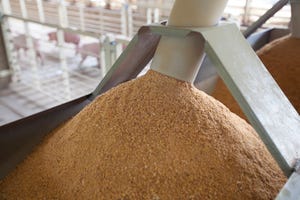Some specific mutations in the spike protein of the novel virus, tentatively called swine enteric alphacoronavirus, are presumably responsible for it being able to jump from bats to pigs.
October 26, 2017

Source: Swine Health Information Center
The bat enteric coronavirus strain HKU2, identified in Guangdong and Hong Kong in 2004 and 2006, has recently moved from bats to pigs in China, causing severe piglet diarrhea and mortality.
Some specific mutations in the spike protein of the novel virus, tentatively called swine enteric alphacoronavirus, are presumably responsible for it being able to jump from bats to pigs. The Swine Health Information Center has gathered information to inform the SHIC Monitoring and Analysis Working Group and help them reach a consensus for guidance about next steps.
Published papers (“A New Bat-HKU2–like Coronavirus in Swine, China, 2017” and “Discovery of a novel swine enteric alphacoronavirus (SeACoV) in southern China”) and contacts in China indicated there were several pig farms in one region suffering from piglet diarrhea in the first half of 2017, resulting in serious piglet loss. Affected piglets on two farms showed morbidity and mortality to the same extent as when porcine epidemic diarrhea reemerged there in 2010.
SHIC also reached out to allied industry for information on the outbreak in China. Chinese groups are continuing research, running deep sequencing on field samples and providing further resources and information on the outbreak as it is being monitored. Because current information shows there has not yet been region-to-region spread in China, the SHIC Working Group arrived at a consensus that SHIC should closely monitor the situation, but not devote resources for diagnostics or to further investigate this virus unless there develops evidence of interregional spread in China, indicating this is more than an isolated incident.
As a reminder, in incidents of high or ongoing morbidity or mortality where an etiology is either not identified or there is a strong suspicion that the identified etiology is not the likely cause of the outbreak, SHIC is offering diagnostic fee support after the initial diagnostic workup is completed and paid for by the owner. In these cases, additional support for the fees of further diagnostic workup may help to identify newly introduced or emerging swine diseases. A description of the requirements, submission and review process for the Support for Diagnostic Fees program can be found on the SHIC website.
Funded by America’s pork producers to protect and enhance the health of the U.S. swine herd, SHIC focuses its efforts on prevention, preparedness and response. As a conduit of information and research, SHIC encourages sharing of its publications and research for the benefit of swine health. For more information, visit SHIC’s website or contact Paul Sundberg.
You May Also Like



